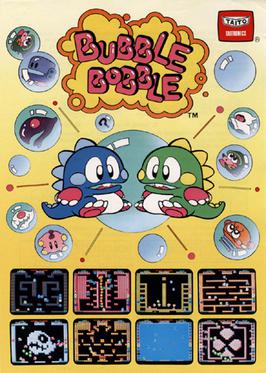
Bubble Bobble is a 1986 platform game developed and published by Taito for arcades. It was distributed in the United States by Romstar, and in Europe by Electrocoin. Players control Bub and Bob, two dragons that set out to save their girlfriends from a world known as the Cave of Monsters. In each level, Bub and Bob must defeat each enemy present by trapping them in bubbles and popping, who turn into bonus items when they hit the ground. There are 100 levels total, each becoming progressively more difficult.

A platformer is a sub-genre of action video games in which the core objective is to move the player character between points in an environment. Platform games are characterized by levels with uneven terrain and suspended platforms of varying height that require jumping and climbing to traverse. Other acrobatic maneuvers may factor into the gameplay, such as swinging from vines or grappling hooks, jumping off walls, gliding through the air, or bouncing from springboards or trampolines.

Darkwing Duck is an American animated superhero comedy television series produced by Disney Television Animation that first ran from 1991 to 1992 on both the syndicated programming block The Disney Afternoon and Saturday mornings on ABC. A total of ninety-one episodes were aired. It features the adventures of Darkwing Duck, who is the superheroic alter-ego of ordinary suburban duck Drake Mallard.

DuckTales is a platform game developed and published by Capcom and based on the Disney animated TV series of the same name. It was first released in North America for the Nintendo Entertainment System in 1989 and was later ported to the Game Boy in 1990. The story involves Scrooge McDuck traveling around the globe collecting treasure and outwitting his rival Flintheart Glomgold to become the world's richest duck.
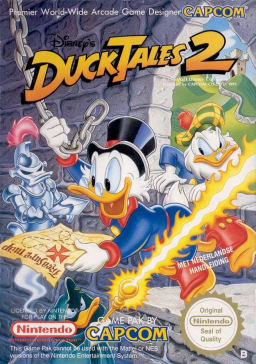
DuckTales 2 is a platform video game developed and published by Capcom. It is a sequel to the original DuckTales based on the Disney animated series of the same name. It was released on the Nintendo Entertainment System in early 1993. The title was ported to the Game Boy handheld system in Japan and North America at the end of the year.

Darkwing Duck is a platform video game developed and published by Capcom for the Nintendo Entertainment System in 1992. It was based on the Disney animated television series Darkwing Duck. It was ported to the Game Boy in 1993.
The Bugs Bunny Crazy Castle is a 1989 puzzle video game developed by Kemco for the Nintendo Entertainment System. In 1990, it was released with the same title for the Game Boy in North America and Europe. In Japan, it was released for the Disk System as Roger Rabbit, and then for the Game Boy as Mickey Mouse.
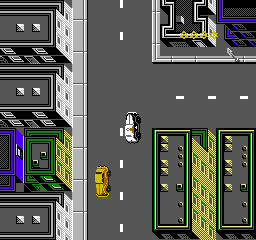
Dick Tracy appeared in the following video game tie-ins for the motion picture:

Chip 'n Dale Rescue Rangers is a platform game developed and published by Capcom based on the Disney animated series of the same name. Originally released for the Nintendo Entertainment System in Japan and North America in 1990, it came to Europe the next year, and was ported to the Nintendo PlayChoice-10 arcade system. It sold approximately 1.2 million copies worldwide.
Disney's Magical Quest is a Disney platform game trilogy released by Capcom. The games star Mickey Mouse and either Minnie Mouse or Donald Duck, who must defeat Pete. The gameplay is similar amongst all games in the series: the player must move as in a typical platform game, defeating enemies either by jumping on them or by grabbing and throwing blocks at them.

The Legendary Axe is a horizontal platform video game for the TurboGrafx-16. It was developed and published by Victor Musical Industries in Japan and by NEC in North America. It was released in Japan on September 23, 1988 and in North America as a TurboGrafx-16 launch title on August 29, 1989. In the game, the player controls Gogan, a barbarian whose girl, Flare, was kidnapped by the cult of Jagu. The player must navigate through six platforming levels, armed with a legendary axe named "Sting" to defeat Jagu and his minions and rescue Flare. The game features a rechargeable "strength meter" that determines how much damage is dealt from the axe to enemies.

Chew Man Fu is a 1990 action video game developed by Now Production and published in Japan by Hudson Soft and in North America by NEC for the TurboGrafx-16.

God of War: Betrayal is an action-adventure mobile game developed by Javaground and Sony Online Entertainment's (SOE) Los Angeles division, and published by Sony Pictures Digital. Released for mobile phones supporting the Java Platform, Micro Edition on June 20, 2007, it is the third installment in the God of War series, and the fifth chronologically. Loosely based on Greek mythology, Betrayal is set in ancient Greece with vengeance as its central motif. The player controls the protagonist Kratos, who became the new God of War after killing the former, Ares. Kratos is framed for the murder of Argos and pursues the true assassin across Greece, resulting in a confrontation with Olympian messenger Ceryx.

Chip 'n Dale Rescue Rangers: The Adventures in Nimnul's Castle is an action video game developed by Riedel Software Productions and co-published by Hi Tech Expressions and Walt Disney Computer Software based on the Disney animated series of the same name. The game was released in March 1990 for MS-DOS.

The Lucky Dime Caper Starring Donald Duck, released in Japan as Donald Duck no Lucky Dime, is a platform game released by Sega for the Game Gear and Master System in 1991. It features Donald Duck as the main character. Another game featuring Donald Duck for the Game Gear and Master System, Deep Duck Trouble, was released in 1993.

Mickey no Tokyo Disneyland Daibōken is a video game for the Super Famicom game console starring Mickey Mouse. It was published by Tomy on December 16, 1994 in Japan. This game has 6 levels.

Batman: The Video Game is a platform game developed by Sunsoft for the Nintendo Entertainment System, loosely based on the 1989 film Batman. The game contains five levels culminating in a showdown with the Joker in the bell tower of Gotham Cathedral. It was received well.
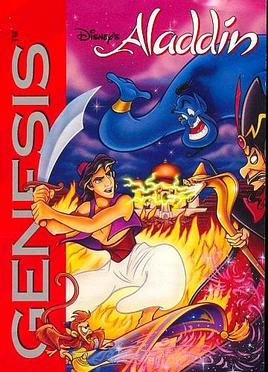
Disney's Aladdin is a platform game based on the 1992 film of the same name developed by Virgin Games USA. The game was released by Sega for the Sega Genesis on November 11, 1993 as one of several games based on the film, including another game that was released in the same month by Capcom for the Super NES.
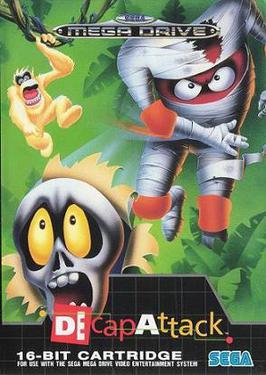
Decap Attack is a 1991 platform game developed by Vic Tokai and published by Sega for the Genesis. The game is a westernized version of the 1990 Japanese Mega Drive game Magical Hat no Buttobi Tābo! Daibōken, with the art, plot, music, and level designs all being changed. Both are updates of the late 1980s games Kid Kool and Psycho Fox. The game has also been released as part of several emulated compilations.

















